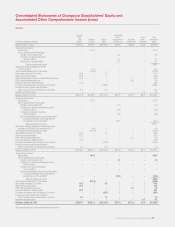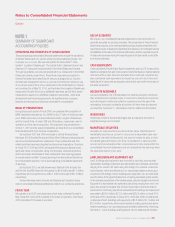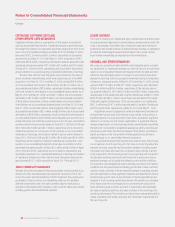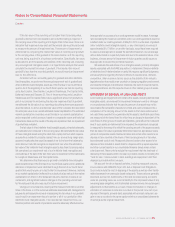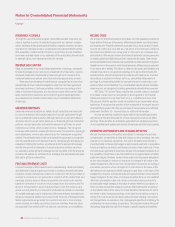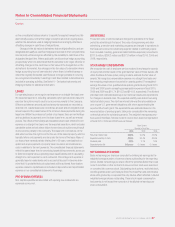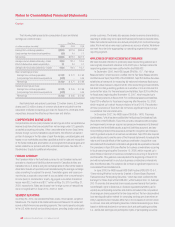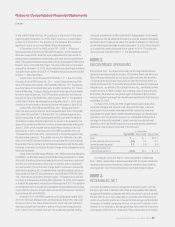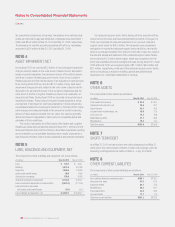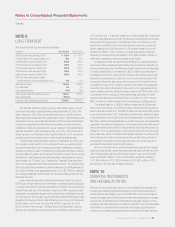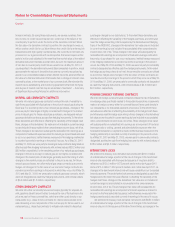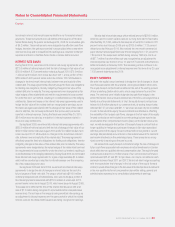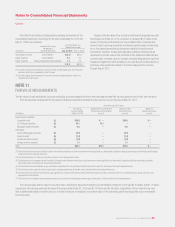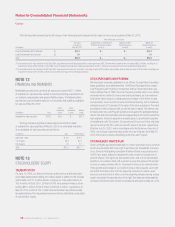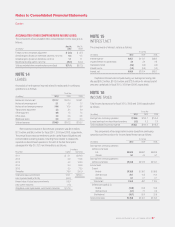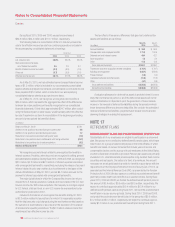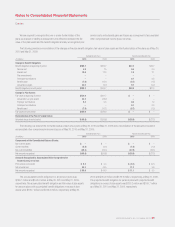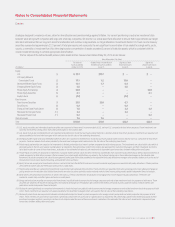Red Lobster 2010 Annual Report Download - page 53
Download and view the complete annual report
Please find page 53 of the 2010 Red Lobster annual report below. You can navigate through the pages in the report by either clicking on the pages listed below, or by using the keyword search tool below to find specific information within the annual report.
NOTE 9
LONG-TERM DEBT
The components of long-term debt are as follows:
(in millions) May 30, 2010 May 31, 2009
4.875% senior notes due August 2010 $ 150.0 $ 150.0
7.450% medium-term notes due April 2011 75.0 75.0
5.625% senior notes due October 2012 350.0 350.0
7.125% debentures due February 2016 100.0 100.0
6.200% senior notes due October 2017 500.0 500.0
6.000% senior notes due August 2035 150.0 150.0
6.800% senior notes due October 2037 300.0 300.0
ESOP loan with variable rate of interest
(0.65% at May 30, 2010) due December 2018 9.8 11.6
Total long-term debt 1,634.8 1,636.6
Fair value hedge 3.8 1.3
Less issuance discount (4.9) (5.6)
Total long-term debt less issuance discount 1,633.7 1,632.3
Less current portion (225.0)–
Long-term debt, excluding current portion $1,408.7 $1,632.3
We maintain a $750.0 million revolving credit facility under a Credit
Agreement (Revolving Credit Agreement) dated September 20, 2007 with
Bank of America, N.A. (BOA), as administrative agent, and the lenders
(Revolving Credit Lenders) and other agents party thereto. The Revolving Credit
Agreement is a senior unsecured debt obligation of the Company and contains
customary representations, affirmative and negative covenants (including
limitations on liens and subsidiary debt, and a maximum consolidated lease
adjusted total debt to total capitalization ratio of 0.75 to 1.00) and events of
default usual for credit facilities of this type. As of May 30, 2010, we were in
compliance with all covenants under the Revolving Credit Agreement.
The Revolving Credit Agreement matures on September 20, 2012, and
the proceeds may be used for commercial paper back-up, working capital
and capital expenditures, the refinancing of certain indebtedness as well as
general corporate purposes. The Revolving Credit Agreement also contains a
sub-limit of $150.0 million for the issuance of letters of credit. The borrowings
and letters of credit obtained under the Revolving Credit Agreement may be
denominated in U.S. Dollars, Euro, Sterling, Yen, Canadian Dollars and each
other currency approved by the Revolving Credit Lenders. The Company may
elect to increase the commitments under the Revolving Credit Agreement by
up to $250.0 million (to an aggregate amount of up to $1.0 billion), subject to
the Company obtaining commitments from new and existing lenders for the
additional amounts.
Loans under the Revolving Credit Agreement bear interest at a rate of
LIBOR plus a margin determined by reference to a ratings-based pricing grid,
or the base rate (which is defined as the higher of the BOA prime rate and the
Federal Funds rate plus 0.500 percent). Assuming a “BBB” equivalent credit
rating level, the applicable margin under the Revolving Credit Agreement will
be 0.350 percent. We may also request that loans under the Revolving Credit
Agreement be made at interest rates offered by one or more of the Revolv ing
Credit Lenders, which may vary from the LIBOR or base rate, for up to
$100.0 million of borrowings. The Revolving Credit Agreement requires
that we pay a facility fee on the total amount of the facility (ranging from
0.070 percent to 0.175 percent, based on our credit ratings) and, in the event
that the outstanding amounts under the Revolving Credit Agreement exceeds
50 percent of the aggregate commitments under the Revolving Credit
Agreement, a utilization fee on the total amount outstanding under the
facility (ranging from 0.050 percent to 0.150 percent, based on our credit
ratings). As of May 30, 2010, we had no outstanding balances under the
Revolving Credit Agreement. As of May 30 2010, $58.4 million of letters of
credit were outstanding, which are backed by this facility.
In September 2008, Lehman Brothers Holdings Inc. (Lehman Brothers)
and certain of its subsidiaries filed for bankruptcy protection. A subsidiary of
Lehman Brothers was one of the Revolving Credit Lenders under our Revolving
Credit Agreement with a commitment of $50.0 million, and defaulted on
its obligation to fund our request for borrowings under the Revolving Credit
Agreement. Accordingly, our ability to borrow under the Revolving Credit
Agreement effectively was reduced by the amount of Lehman Brothers’
commitment. In April 2010, however, Lehman’s commitment was assigned
to another then-existing Revolving Credit Lender, so the aggregate commit-
ments available under our facility have been restored to $750.0 million. After
consideration of borrowings currently outstanding and letters of credit
backed by the Revolving Credit Agreement, as of May 30, 2010, we had
$691.6 million of credit available under the Revolving Credit Agreement.
The interest rates on our $350.0 million of unsecured 5.625 percent
senior notes due October 2012, $500.0 million of unsecured 6.200 percent
senior notes due October 2017 and $300.0 million of unsecured 6.800 percent
senior notes due October 2037 (collectively, the New Senior Notes) is subject
to adjustment from time to time if the debt rating assigned to the series of the
New Senior Notes is downgraded below a certain rating level (or subsequently
upgraded). The maximum adjustment is 2.000 percent above the initial interest
rate and the interest rate cannot be reduced below the initial interest rate. As
of May 30, 2010, no adjustments to these interest rates had been made. We
may redeem any series of the New Senior Notes at any time in whole or from
time to time in part, at the principal amount plus a make-whole premium. If
we experience a change of control triggering event, we may be required to
purchase the New Senior Notes from the holders.
All of our long-term debt currently outstanding is expected to be repaid
entirely at maturity with interest being paid semi-annually over the life of the
debt. The aggregate maturities of long-term debt for each of the five fiscal
years subsequent to May 30, 2010, and thereafter are $225.0 million in
2011, $0.0 million in 2012, $350.0 million in 2013, $0.0 million in 2014,
$0.0 million in 2015 and $1.06 billion thereafter.
NOTE 10
DERIVATIVE INSTRUMENTS
AND HEDGING ACTIVITIES
We enter into derivative instruments for risk management purposes only,
including derivatives designated as hedging instruments as required by
the Derivatives and Hedging Topic of the FASB ASC, and those utilized as
economic hedges. We use financial and commodities derivatives to manage
interest rate, compensation and commodities pricing and foreign currency
exchange rate risks inherent in our business operations. Our use of derivative
instrumentsiscurrentlylimitedtointerestratehedges;equityforwards
contracts;commoditiesfuturesandoptionscontractsandforeigncurrency
DARDEN RESTAURANTS, INC. | 2010 ANNUAL REPORT 51
Notes to Consolidated Financial Statements
Darden


